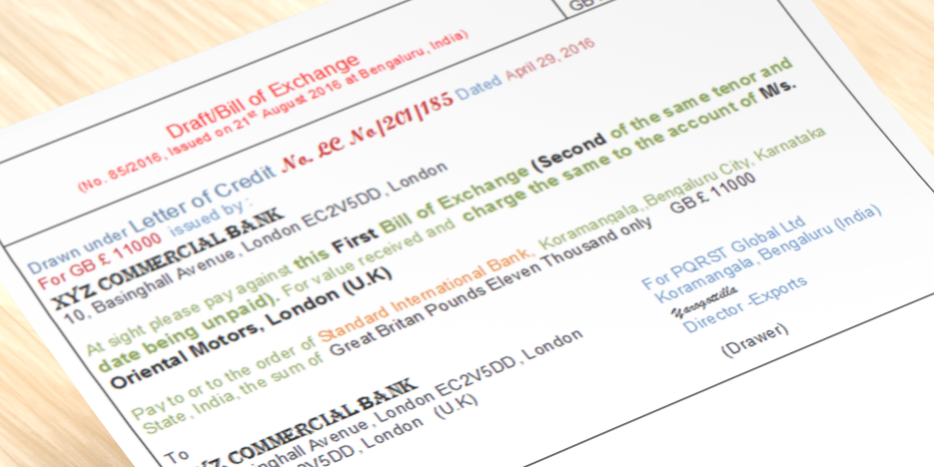A bill of exchange is a negotiable instrument issued by the seller (the creditor) and orders the buyer (the debtor) to pay a particular amount within a given period of time for the goods supplied or services rendered by the seller. On the due date of payment, the financial intermediary or the seller directly collects the money from the buyer. Normally, the transaction happens through the banks.
The Bill of exchange can involve up to three parties. The drawer is the maker of a bill of exchange(who makes and signs the bill). Drawee is the person upon whom the bill of exchange is drawn and he has to pay the money specified by the bill of exchange on the maturity date of the bill. The drawee becomes the acceptor when he has written the acceptance on the bill of exchange. The beneficiary or payee is the party to which the bill of exchange is payable. The payee may be the drawer himself or a third party. The holder of a bill of exchange is the person who is entitled to receive payment either from the drawee or acceptor of the bill. (Generally, the acceptor is the drawee but on some occasion, a third party may accept it too).
Bill discount system in banks
A bill of exchange is a negotiable instrument that is negotiable mere by endorsing the name. Bill discounting is an arrangement whereby the seller (customer of the bank) approaches his bank/NBFC to discount the bill held by him before it is due. The bank cuts some amount from the bill amount (face value of the bill) and pays the remaining amount, called the discounted value of the bill to the borrower. The difference between the bill amount and the amount paid to the customer is the amount of discount collected by the bank. The discount collected by the bank is actually the interest collected on the face value of the bill for the period from the date of bill discount up to the maturity date of the bill. The Bank then presents the Bill to the borrower’s customer on the due date of the Bill and collects the total amount. On the date of maturity, the bank receives full payment (face value of the bill) from the drawee. If the bill is delayed, the borrower or his customer pays the Bank a pre-determined interest depending upon the terms of the transaction. Bill Finance constitutes a vital part of the working capital finance and is a major Trade Finance activity.
Due date and maturity date:
Drawee is given three extra days following the due date of the bill for making payment as a custom. Adding 3 days to the due date is known as the maturity date. These 3 days are known as ‘Days of Grace’. For example, if the bill is drawn on September 10 and its maturity is 1 month then the due date of the bill is October 10, and the maturity date is October 10+3 days that is 14th October.
Explanation::
Suppose a bill of Rs 100000 drawn on 10th September is discounted by the bank on September 27, at 8% p.a. Maturity date (legally due date after 3 days grace) of the bill is 14th October. We shall now calculate how much amount of discount collected by the bank and what is the discounted value of the bill.
Solution:
The discount to be collected from September 27 to October 14= 18 days
Discount rate is 8%
Amount A=Rs100000
Interest i=8/100 =0.08
Discount D= Rs10000×0.08×18/365 = Rs 394.50
Discounted proceeds (Face value of the bill-discount) = 100000-394.50=99605.50
Difference between discount rate and effective rate of Interest:
The rate of interest charged on loan/advances denotes the rate of interest charged by the bank on a loan/advance of Rs.100 for one year. Suppose, a bank charge Rs.8 per year on the borrowing of Rs.100, it is expressed as the rate of interest charged by the bank is at 8% p.a. However, in case the bank discounts the customer’s bill at 8% per annum, it means the customer gets Rs.92 as proceeds of the bill as the bank collected Rs.8 as a discount for one year on a bill of face value Rs. 100. Here the discount rate is (100-92)/100= 8.00% per annum. But the point to be noted is the bank collects Rs.8 as a discount for its advance of Rs.92 (not for an advance of Rs.100), which means the discount rate is not the same as the effective interest rate. Let us find out what is the effective interest rate if the discount rate is 8% as calculated below.
Discount amount is Rs.8, Value of discount proceeds is (Rs.100-8) = Rs.92
Effective interest rate=Discount amount ×100/ value of Discount proceeds
I.e.Effective interest rate= 8×100/92= 8.69 % per annum
Click below for related articles:
- Checklist for banks financing LC/ co-accepted bills
- Meaning of inland bills and foreign bills
- Meaning of DP bills, DA bills, and Acceptance of Bills,
- What is co-acceptance of bills?
- What are the Clean Bill, Documentary bill, Demand bill, Usance Bill, and Accommodation Bill
- Crystallization of overdue export bills
- Crystallization of Import LC bills
- Post shipment finance to exporters without packing credit facility
- How to liquidate packing credit loans without post-shipment finance?
- Meaning of Normal transit period and notional due date
- What is forfaiting
- What is International factoring?






